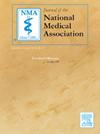Underrepresented in medicine resident physician distribution by race, gender, and specialty trends from 2013–2019
IF 2.5
4区 医学
Q1 MEDICINE, GENERAL & INTERNAL
引用次数: 0
Abstract
Importance: While significant racial disparities in the physician workforce have existed for decades, recent attention on this mismatch and the current sociopolitical climate have led to an increase in recruitment efforts of Underrepresented in Medicine (URiM) physicians by residency programs. The effect of these efforts on URiM distribution across residency programs has not yet been comprehensively studied. Objective: To describe the distribution of URiM residents across the top 20 most populous medical and surgical specialties by race and gender as well as trends observed from 2013 to 2019. Design: Multicenter, retrospective cross sectional analysis Setting: US residency programs Participants: All first-year residents matching in the 20 most populous specialties as documented in the Association of American Medical Colleges (AAMC) Data Resource Books during the study period. Main Outcomes: The primary outcome of this study was to describe the percentages of URiM resident physicians in the US by race and gender, as defined by the AAMC during the study period. Secondary outcomes include an analysis of URiM race and gender distribution as well as URiM distribution in competitive vs noncompetitive specialties, surgical vs nonsurgical specialties, and primary care specialties. Results: From 2013-2019, there were 228,645 entries by 211,356 first-year residents to the top 20 most populous specialties. In total, 15.2% of entries were URiM residents. Forty-six percent of applicants identified as female. All but two specialties studied had an increase in URiM representation. No specialty had greater than 4% increase in URiM representation. In 2019, there were differences in specialty representation when individual race and gender categories within URiM were considered. The URiM percentages were as follows in specialty subtypes: surgical (16%) vs nonsurgical (16.4%) and competitive (12.3%) vs noncompetitive (18.2%). The top 3 specialities with the highest percentage of URiM residents were primary care specialties. Conclusion: Despite the increase in recruitment efforts for URiM applicants at the residency level, there was only a slight change in total URiM distribution by specialty over the study time period. Individual race categories and gender had an impact on the distribution of residents in the most recent year
2013-2019 年按种族、性别和专业趋势分列的医学住院医生不足人数分布情况。
重要性:虽然医生队伍中存在显著的种族差异已经存在了几十年,但最近对这种不匹配的关注和当前的社会政治气候导致住院医师计划招募医学中代表性不足(URiM)医生的努力增加。这些努力对住院医师项目中URiM分布的影响尚未得到全面研究。目的:描述2013年至2019年按种族和性别划分的前20个人口最多的内科和外科专业的URiM居民分布以及趋势。设计:多中心,回顾性横断面分析设置:美国住院医师项目参与者:所有一年级住院医师在研究期间符合美国医学院协会(AAMC)数据资源书中记录的20个人口最多的专业。主要结局:本研究的主要结局是描述在研究期间由AAMC定义的美国URiM住院医师按种族和性别的百分比。次要结局包括对URiM种族和性别分布的分析,以及竞争与非竞争专科、外科与非手术专科和初级保健专科的URiM分布。结果:2013-2019年,共有211,356名一年级住院医师228,645人次进入前20个人口最多的专科。总共有15.2%的入境者是乌林居民。46%的申请者被认定为女性。除了两个专业外,所有专业的URiM比例都有所增加。没有一个专业的URiM比例增加超过4%。2019年,考虑到URiM内部的个人种族和性别类别,专业代表性存在差异。专科亚型的URiM百分比如下:手术(16%)对非手术(16.4%)和竞争性(12.3%)对非竞争性(18.2%)。URiM居民比例最高的前3名专业是初级保健专业。结论:尽管在住院医师水平上,URiM申请人的招聘工作有所增加,但在研究期间,按专业划分的URiM总分布只有轻微变化。最近一年,个别种族类别和性别对居民的分布产生了影响。
本文章由计算机程序翻译,如有差异,请以英文原文为准。
求助全文
约1分钟内获得全文
求助全文
来源期刊
CiteScore
4.80
自引率
3.00%
发文量
139
审稿时长
98 days
期刊介绍:
Journal of the National Medical Association, the official journal of the National Medical Association, is a peer-reviewed publication whose purpose is to address medical care disparities of persons of African descent.
The Journal of the National Medical Association is focused on specialized clinical research activities related to the health problems of African Americans and other minority groups. Special emphasis is placed on the application of medical science to improve the healthcare of underserved populations both in the United States and abroad. The Journal has the following objectives: (1) to expand the base of original peer-reviewed literature and the quality of that research on the topic of minority health; (2) to provide greater dissemination of this research; (3) to offer appropriate and timely recognition of the significant contributions of physicians who serve these populations; and (4) to promote engagement by member and non-member physicians in the overall goals and objectives of the National Medical Association.

 求助内容:
求助内容: 应助结果提醒方式:
应助结果提醒方式:


